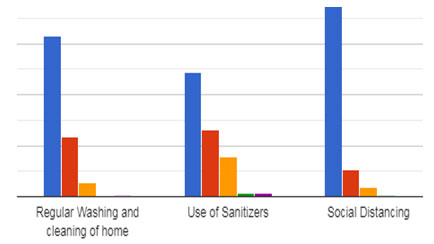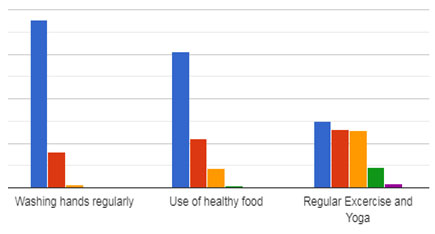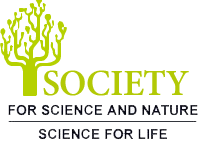1Institute of Pharmaceutical Research, GLA University, Mathura, India.
2SRMS College of Engineering and Technology, Bareilly, India.
Corresponding author email: isha.mishra@gla.ac.in
Article Publishing History
Received: 04/07/2021
Accepted After Revision: 28/09/2021
Since the dawn of modern human civilization, the daily lifestyle of humans has been evolved so many times because of either cultural, political, social effects or calamities and epidemics. Whenever any community faces an epidemic, it makes everyone learn a lot many new things for a better life and this time it was not a single commonality but the whole world which was facing a common pandemic COVID-19 which almost stopped the whole world for a time. The phrase normal life has now been converted to a new normal life where people became used to certain precautions to prevent themselves from COVID-19. The use of masks and sanitizers has become a part of day-to-day life but besides that there are many houses routine precautions that are being followed by us to save our families from the pandemic. In India, women are doing so many things for the safety of themselves and their families.
In this paper, one online survey has been conducted for Indian women to find out the actual scenario of their preventive actions against COVID-19. This online survey was conducted on women belonging to different professions to check if the profession affects the perception and preferences of women for COVID-19 safety measures or not. The statistical analysis was then applied to the survey data collected. To analyze the results, a factor analysis, reliability test followed by ANOVA test was applied through SPSS tool. At last, the relation between Indian women’s approach and their profession has been evaluated and it was found that there was no significant relationship between women’s profession and her COVID-19 safety preferences.
Covid-19, Medical Solution, Preferences, Statistical Analysis, Survey.
Mishra I, Agarwal A, Mishra R. Preferences of Indian Women on COVID-19 Medical Solutions. Biosc.Biotech.Res.Comm. 2021;14(3).
Mishra I, Agarwal A, Mishra R. Preferences of Indian Women on COVID-19 Medical Solutions. Biosc.Biotech.Res.Comm. 2021;14(3). Available from: <a href=”https://bit.ly/3z301bO“>https://bit.ly/3z301bO</a>
Copyright © This is an Open Access Article distributed under the Terms of the Creative Commons Attribution License (CC-BY). https://creativecommons.org/licenses/by/4.0/, which permits unrestricted use distribution and reproduction in any medium, provided the original author and sources are credited.
INTRODUCTION
With the rise in the World’s population, health issues are indeed increasing. In the past decades, the World’s unsettling level has risen as a result of life-treating infectious diseases caused by microorganisms. An emerging disease is an infectious disease that has arisen or is spreading rapidly in the population or geographical area recently (Hatfill et al. 2014; Mishra et al. 2017; Mishra et al. 2018). At the end of (2019), China began to see the initial epidemic situation and later in a few months that became a pandemic. India is also one of the very first countries to face a global coronavirus-induced COVID-19 pandemic. On 4 September 2020, India has seen more than 4,020,239 cases and more than 69,635 deaths because of COVID-19 (Mishra et al. 2021).
India has a significant number of COVID patients amid repeated lockdowns. Government plays a major role across every nation in developing and applying appropriate rules and regulations and issuing various advisories. But only Government cannot do everything, all people are expected to do their part, by respecting all advisories and provisions, to protect themselves and others from the COVID-19 virus. Covid-19 has affected India and the world on global scale. Following the SARS-CoV-2 epidemic, various countries like India introduced travel restrictions and visa suspensions. To monitor the tragedy, it is necessary to take ordinary care of the houses and emergency clinics (Hatfill et al. 2014; Mishra et al. 2021).
The normal proposal to limit the disease is-cleaning off your zone. The most critical thing is not to sneeze and cough on the public spot. It is necessary to clean hands with soap and sanitizer, wear the mouth and nose mask while sneezing and coughing. Careful food washing can aid in this respect before cooking. The outbreak can be managed periodically by surface cleaning by disinfectants. Interactions with others having signs including sneezing, coughing, respiratory problems, etc should always be avoided (Hatfill et al. 2014).
On December 30, 2019, the primary example of the novel coronavirus was represented in Wuhan city, 2 Hubei districts, P.R. China (Qamar et al. 2020; Wang et al. 2020). The Center for Disease Control and Prevention (CDC), the Chinese authorities, and experts took swift steps. It was soon identified as a novel coronavirus (2019-nCoV) by the World Health Organization (WHO) (Cui et al. 2019; Lai et al. 2020; Mishra et al. 2021).
As of May 01, 2021, a total of 19,164,969 affirmed cases, 15,684,406 recouped cases, and 211,853 passing were represented in India (Barman et al. 2020; Wang et al. 2020). According to information accessible on different sites concerning COVID-19 diseases around the World, the cases are expanding exponentially. On May 01, 2021, in World, there were 152,038,419 announced cases, which included 3,194,337 deaths and 129,328,584 recovered cases.
On 15 August 2020 i.e., Independence Day of India, the total number of cases confirmed was more than 2.53 M; the death toll was about 50,040 (Ramteke et al. 2020). In this paper, one survey study has been conducted by the authors to study the preventive measures taken by Indian women to prevent their families from pandemic from COVID-19. It has also been evaluated if there was any relationship between the professional of Indian women and preventive measures taken by them against COVID-19.
MATERIAL AND METHODS
Since the goal was to perform a study explicitly on the viewpoint of women during the lockdown process, the best approach was to perform an outline survey to reach the maximum population. Google’s form, a feature Google used to create a questionnaire on the survey form. For the pilot analysis, the questionnaire was sent to experts and then this questionnaire was circulated over emails, social media channels etc. In this research work, only some of the questions and answers were used as per the necessity according to the hypothesis taken.
A total of 225 responses have been received but only 222 answers have been taken as a sample for this report. All the respondents were females belonging to the various Indian States. All the respondents belonged to at least one category from the list having three options as working in any organization, running their own business, and smart house maker.
The survey form was sent through online modes so that the data was also collected online. The data was stored in Google Form Excel sheets created automatically so that all data was protected and not editable. The parameters taken in the Likert scale question were the use of sanitizers, washing and cleaning, social distancing, washing the hands properly, healthy food, and exercise. The respondents were asked to select one Likert scale category according to their preference for the given parameter.
RESULTS AND DISCUSSION
Figure 1 and 2 shows the responses given by Indian women about their preference for various preventive measures against COVID 19. The graph was plotted on a scale of 25, 50, 75, 100, and so on.
Figure 1: Indian Women’s Response for various preventive measures against COVID-19

Figure 2: Indian Women’s Response for various other preventive measures

- Null Hypothesis 1: There was “no significant relationship” between the profession of Indian women and their choice of using different parameters to save their home from COVID-19.
- Alternative Hypothesis 1: There was a “significant relationship” between the profession of Indian women and their choice of using different parameters to save their home from COVID-19.
Various studies have been reported related to impact of COVID-19 on various aspects of woman upon searching on various electronic databases (Kapoor et al. 2019; Laxminarayan et al. 2020; Kumar et al. 2020; Han et al. 2020; Kelley et al. 2020; Akseer et al. 2020; Roberton et al. 2020). Overall, the primary symptoms of COVID-19 were less likely to be recognized by women due to problems in accessing information or less accurate COVID-19 information. Women were also less likely to practice the most effective preventive activities and to report depressive symptoms (Pinchoff et al. 2020).
In 2020, the broad data was published on the outbreak of COVID 19 in India and in reference to that study, an analysis on the precautions taken by Indian women against COVID 19 has been analyzed in this manuscript (Khandelwal et al. 2020). Among Indian women, around 225 responses were collected, and finally, 222 responses were taken for the analysis. Some of the responses were removed because of some missing values and blank fields.
Table 1. Reliability Analysis
| Reliability Statistics | |
| Cronbach’s Alpha | No. of Items |
| 0.667 | 6 |
For the analysis of both hypotheses, the authors had first performed the reliability test on SPSS statistical tool. Table 1 shows the reliability analysis performed on the parameters taken with a question in the survey questionnaire. Firstly, we performed reliability analysis to check if all the factors taken were properly interrelated as Cronbach alpha (0.667) was greater than 0.5.
It showed a good co-relation. After that we perform factor analysis wherein, we got a combined value for all these factors, and then we did regression wherein the dependent variable was the combined value of factor and the independent variable was the profession. Therein we found that the significance value was 0.545 and hence null hypothesis was accepted. Table 2 shows various parameters considered for the hypothesis. Further, the extraction values calculated with principal component analysis for each parameter are also shown in Table 2.
Table 2. Various parameters with principal component analysis
| Communalities | ||
| Initial | Extraction | |
| Wash Clean | 1.000 | 0.613 |
| Sanitizers | 1.000 | 0.612 |
| Social Distancing | 1.000 | 0.542 |
| Wash hands | 1.000 | 0.390 |
| Healthy Food | 1.000 | 0.657 |
| Exercise | 1.000 | 0.635 |
*Extraction Method: Principal Component Analysis
Table 3 shows total variance analysis with factor analysis.
Table 3. Total Variance Analysis
| Total Variance explained | ||||||
| Initial Eigen Values | Extraction Sums of Squared Loadings | |||||
| Component | Total | % of Variance | Cumulative % | Total | % of Variance | Cumulative % |
| 1 | 2.408 | 40.137 | 40.137 | 2.408 | 40.137 | 40.137 |
| 2 | 1.041 | 17.358 | 57.495 | 1.041 | 17.358 | 57.495 |
| 3 | 0.872 | 14.541 | 72.036 | |||
| 4 | 0.658 | 10.96 | 82.996 | |||
| 5 | 0.58 | 9.661 | 92.657 | |||
| 6 | 0.441 | 7.343 | 100 | |||
* Extraction Method: Principal Component Analysis
Table 4 and Table 5 are generated after performing the ANOVA test on SPSS. The significant value generated was 0.545 which showed that the null hypothesis cannot be rejected.
Table 4. ANOVA Test Analysis
| Model | R | R square | Adjusted R square | Std. error of the estimate |
| 1 | 0.41a | 0.002 | -0.003 | 1.00143225 |
* Predicators (Constant), Profession
Table 5. ANOVA Test variable Analysis
| Model | Sum of Square | df a | Mean Square | F | Sig. |
| Regression | 0.369 | 1 | 0.369 | 0.368 | 0.545 |
| Residual | 220.631 | 220 | 1.003 | ||
| Total | 221 | 221 |
a Degree of Freedom
* Dependent Variable: REGR factor score 1 for analysis 1
* Predicators (Constant), Profession
CONCLUSION
The findings of the present study reflected that Indian woman is very careful about the risk of COVID-19 and takes all the required precautions. Every woman had been taking proper preventive measures required for the mitigation of COVID-19 but as the null hypothesis was accepted, it showed there was no association between the Indian women’s preferences for safety precautions taken by them and their profession. On 30 January 2020, in Kerala, one of India’s most literate states, the very first case of the novel Coronavirus (COVID-19) was detected, since then a lot of precautions were taken by Indian citizens. Pandemic is still not under global control, and the possibility of continuous infections continues.
ACKNOWLEDGEMENTS
This study was supported by the Department of Pharmacy, GLA University, Mathura, Uttar Pradesh with the necessary infrastructure and facilities to conduct this research work. Authors received no direct funding for this research.
Conflict of interests: Authors declare no conflict of interests to disclose.
Ethical Clearance Statement: The Current Research Work Was Ethically Approved by the Institutional Review Board (IRB) of GLA University, Mathura U.P, India.
REFERENCES
Akseer, N., Kandru, G., Keats, E. C., et al. (2020). COVID-19 pandemic and mitigation strategies: implications for maternal and child health and nutrition. The American Journal of Clinical Nutrition, 112(2): 251-256.
Barman, M. P., Rahman, T., Bora, K., et al. (2020). COVID-19 pandemic and its recovery time of patients in India: A pilot study. Diabetes & Metabolic Syndrome: Clinical Research & Reviews, 14(5): 1205-1211.
Cui, J., Li, F., and Shi, Z. L. (2019). Origin and evolution of pathogenic coronaviruses. Nature Reviews Microbiology, 17(3): 181-192.
Han, E., Tan, M. M. J., Turk, E., et al. (2020). Lessons learnt from easing COVID-19 restrictions: an analysis of countries and regions in Asia Pacific and Europe. Lancet, 396(10261): 1525-1534.
Hatfill, S. J., Nordin, T., and Shapiro, G. L., (2014). Ebola virus disease. Journal of American Physicians and Surgeons, 19(4): 101-114.
Kapoor, M., Agrawal, D., Ravi, S., et al. (2019). Missing female patients: an observational analysis of sex ratio among outpatients in a referral tertiary care public hospital in India. BMJ Open, 9(8): e026850.
Kelley, M., Ferrand, R. A., Muraya, K., et al. (2020). An appeal for practical social justice in the COVID-19 global response in low-income and middle-income countries. The Lancet. Global Health, 8(7): e888-e889.
Kumar, S. U., Kumar, D. T., Christopher, B. P., et al. (2020). The rise and impact of COVID-19 in India. Frontiers in Medicine, 7: 250.
Khandelwal, A., Agrawal, A., and Kumar, A., (2020). An Outbreak of Coronavirus (COVID-19) Epidemic in India: Challenges and Preventions. Journal of Infectious Diseases & Therapy, 8(2): 1-7.
Lai, C. C., Shih, T. P., Ko, W. C., et al. (2020). Severe acute respiratory syndrome coronavirus 2 (SARS-CoV-2) and corona virus disease-2019 (COVID-19): The epidemic and the challenges. International Journal of Antimicrobial Agents, 55(3): 1-9.
Laxminarayan, R., Jameel, S., and Sarkar, S. (2020). India’s battle against COVID-19: Progress and challenges. The American Journal of Tropical Medicine and Hygiene, 103(4): 1343-1347.
Mishra, I., and Chaudhary, K., (2021). Impact of COVID-19 on Pharmacovigilance in India: An Overview. International Journal of Biology, Pharmacy and Allied Sciences, 10(7): 2379-2391.
Mishra, I., Mishra, R., Mishra, S., et al. (2017). Ebola Virus Disease: Recent Advances. Advances in Biological Research, 11(4): 202-211.
Mishra, R., Sachan, N., Kumar, N., et al. (2018). Thiophene Scaffold as Prospective Antimicrobial Agent: A Review. Journal of Heterocyclic Chemistry, 55(9): 2019-2034.
Pinchoff, J., Santhya, K. G., White, C., et al. (2020). Gender specific differences in COVID-19 knowledge, behavior and health effects among adolescents and young adults in Uttar Pradesh and Bihar, India. PloS One, 15(12): e0244053.
Qamar, T. U. M., Alqahtani, S., Alamri, M., et al. (2020). Structural basis of SARSCoV-2 3CLpro and anti-COVID-19 drug discovery from medicinal plants. Journal of Pharmaceutical Analysis, 10(4): 313-319.
Ramteke, S., and Sahu, B. L. (2020). Novel coronavirus disease 2019 (COVID-19) Pandemic: Considerations for the biomedical waste sector in India. Case Studies in Chemical and Environmental Engineering, 2(100029): 100029.
Roberton, T., Carter, E. D., Chou, V. B., et al. (2020). Early estimates of the indirect effects of the COVID-19 pandemic on maternal and child mortality in low-income and middle-income countries: a modelling study. The Lancet. Global Health, 8(7): e901-e908.
Wang, C., Horby, P. W., Hayden, F. G., et al. (2020). A novel coronavirus outbreak of global health concern. Lancet, 395(10223): 470-473.
Wang, H., Wang, Z., Dong, Y., et al. (2020). Phase adjusted estimation of the number of coronavirus disease 2019 cases in Wuhan, China. Cell Discovery, 6(1): 1-8.


